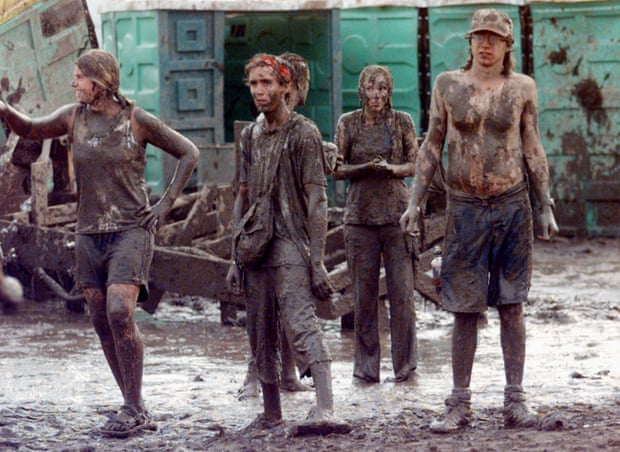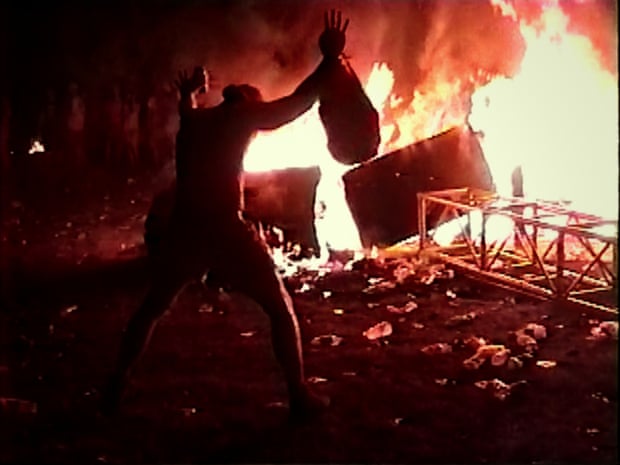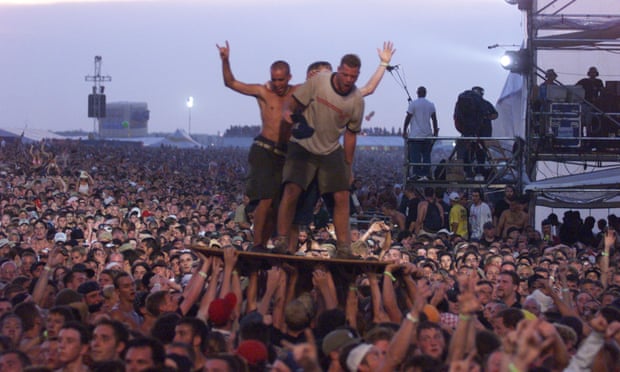NEtflix’s Fyre festival documentary was one of those out-of-the-blue hits that seemed to dominate conversation for months when it was released in 2019. A film about a woefully organized festival that spiraled out of control with alarming ferocity, it was the sort of thing you had to watch through the cracks in your fingers. But something tells me that Fyre festival is going to be superseded, because Netflix is about to release a series about Woodstock 99.
Trainwreck: Woodstock ’99, as it is aptly titled, is a three-part, chronologically told series about one of the most appallingly assembled music festivals in history. Held to commemorate the 30th anniversary of the original Woodstock, which has come to be seen as a benign force of positivity, Woodstock 99 became renowned for the consequences of its spectacularly bad decision-making. The original Woodstock? Held on a dairy farm. This one? An abandoned military base. The original Woodstock had free food kitchens. This one sold plastic water bottles at $4 a pop. The original Woodstock’s lineup included Ravi Shankar and Joan Baez. This one was a celebration of mindlessly aggressive nu-metal. Do not wonder it ended in flames.
Sign up to our Inside Saturday newsletter for an exclusive behind the scenes look at the making of the magazine’s biggest features, as well as a curated list of our weekly highlights.
“It was almost like a perfect experiment,” says Tim Wardle, the show’s executive producer, of the conditions that led to all the chaos. “You could almost look at it as an inadvertent psychological experiment.” What’s so incredible is the speed at which all the contributing factors – the heat, the dehydration, the violence, the drugs – went berserk. At the start of day one, we see the crowd catcalling a rattled Sheryl Crow; by the end of day three, everything is on fire and the police are attacking everyone with sticks.
I speak to Wardle and the show’s producer Cassie Thornton a day after I have hammered through all three episodes in one sitting, and the mayhem is still ringing in my ears. This isn’t necessarily how the pair would like you to enjoy the show. “We watched all the episodes together when we were cutting it, and it’s almost too intense,” says Wardle. “It builds and builds, and you think: ‘Well, it can’t build any more,’ and then it builds again. And then something else happens and it builds again. On a technical level, it’s really interesting in terms of story construction. Just how long can you take without a release?”
One thing the show does well is put the festival in historical context. Post-Columbine and pre-9/11, Woodstock 99 took place when US culture was riddled with examples that appeared to celebrate explosive male entitlement. Fight Club (about men who bond through violence) came out in 1999. American Beauty (about Kevin Spacey essentially being cucked to death) was released in 1999. The biggest band of the time were Limp Bizkit, a toddler tantrum of a project that took Rage Against the Machine’s political fury and evaporated it down to the pointless slogan “break stuff”.
The festival also took place in the infancy of the internet, Wardle points out. “You don’t have people with cameraphones, and there are very few with cellphones. There isn’t the crazy amount of footage you’d have if the festival took place today. But it was also being covered by every rock photographer on the planet. And there were loads of different outlets filming it as well.”

This means that, when things do start to go south, we get to see it from most angles. We watch MTV hosts grow more and more spooked as angry attendees start pelting them with missiles. We see performers look out at the seeingthing crowd with a mixture of awe and horror. And thanks to the Woodstock 99 pay-per-view channel, which was just as intent on filming frat boys gurning at breasts as it was showing music, we see the speed at which mob mentality envelops the crowd.
That really is something to behold. A kind of collective frenzy takes hold from the middle of the second day, and the show demonstrates how dangerous a large group of people can be when they start acting as one. When things get really dark – an attendee steals a van and drives it through the middle of the rave tent during Fatboy Slim’s DJ set, or the crowd start tearing down the sound tower – it is genuinely terrifying. There is blood. There are sexual assaults. It is carnage. forget fyre festival; the closest equivalent I can think of is Four Hours at the Capitol, the recent anxiety-inducing documentary about the 6 January insurrection.
“You can definitely see, certainly visually, parallels between the two,” says Wardle. “And definitely it’s a predominantly – almost exclusively – white, male crowd that’s reacting in this way. But with the more recent situation, it’s been about the breakdown of the norms of political discourse. Back then, it was more or less a Lord of the Flies thing. There were physical conditions that contributed to this. Being deprived of access to water, shade, food and being ripped off. But, you know, human behavior goes to dark places.”

There isn’t a single moment in Trainwreck that will transcend everything else, in the way that Fyre festival had that poor organizer who was prepared to perform oral sex on a stranger for bottled water. This is purely because so many bad decisions were made with such frequency that it’s hard for anything to stand out. But the final performance of the festival comes close. On the Sunday night, Red Hot Chili Peppers performed to a crowd at the absolute end of their tether. The audience were exhausted, dehydrated, on drugs and – thanks to the festival’s insufficient sanitation plan – had spent much of the previous 48 hours splashing around in pools of human effluent.
Towards the end of the set, the Woodstock organizers – in a truly idiotic attempt to revisit the spirit of 1969 – handed out thousands of lit candles, for a planned vigil against gun violence. Inevitably, the furious crowd decided it would be better to use it for the purposes of Arson. This collided with the Chili Peppers’ attempt to revisit the spirit of 69 by performing Jimi Hendrix’s Fire. You couldn’t write a more perfectly sequenced disaster.
Incredibly the festival’s two main organisers, John Scher and Michael Lang, both agreed to extensive interviews in the series. They don’t acquire themselves particularly well – Scher is keen to blame anyone but himself for the debacle, while Lang is slippery and evasive – which makes you wonder why they agreed to take part at all. “On one level they know it went awry, but they also don’t think it was a total disaster,” says Wardle. “And they’re keen to have a say in their legacy. They’d rather they said something than just have other people shape the story.”

“There were some aspects the promoters felt were incredibly positive, and they stand by that,” adds Thornton. “Especially when something is in chaos, if you feel like there are actually positive elements, you want to get out there and share those with the world.” The same can be said for the performers who agreed to take part. Korn’s Jonathan Davis is more than happy to discuss the way he controlled the crowd’s aggression on the first night. Meanwhile, Limp Bizkit’s Fred Durst – who whipped the audience into a state of total uncontrolled violence, crowdsurfed on plywood that rioters had torn off then whined “It was n’t our fault” as he left the stage – is conspicuous by his absence from the. “We did have some early conversations with Durst,” says Wardle. “He was very keen. But then… I do not know if it’s his management team, or whatever. He’s sort of tried to reinvent himself recently. But he decided he didn’t want to take part.”
“I think Jonathan Davis is a very intelligent, nuanced person,” says Thornton. “And he really wanted to come from the perspective of: ‘This was amazing in certain ways, and not so great for many attendees in other ways.’ He felt very open speaking about his 360-degree experience of him. ”
The catastrophic failure of Woodstock 99, not to mention the recent death of Michael Lang, seems to have killed the spirit of Woodstock for ever. But even though this was an unmitigated disaster, it’s important to remember that the original wasn’t that much better. There was a point in 1969 when, fed up with being overcharged for hotdogs, attendees torched some concession stands. And as Wardle points out, “There were sexual assaults and rapes at the original Woodstock as well. History is creating this mythology around the original Woodstock. The original Woodstock never really existed, do you know?
Trainwreck: Woodstock ’99 is on Netflix from 3 Augustt.